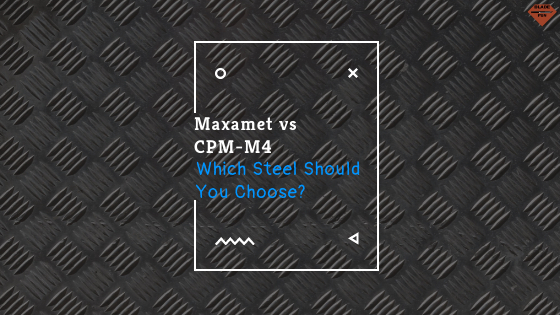Maxamet and CPM-M4 are two high-performance tool steels that are commonly used in the production of knives. Maxamet is a relatively new steel that has gained a lot of attention in the knife community for its exceptional edge retention, while CPM-M4 has been a popular choice for many years due to its excellent wear resistance and toughness. So, which is better?
Here’s the short answer:
Maxamet has better edge retention and corrosion resistance but is more expensive. CPM-M4 is tougher, so it can stand up to more punishment. If you want something for slicing, then go with Maxamet. If you want toughness, then M4 will work well–but make sure to keep it oiled to keep it from rusting.
Now that the short answer is out of the way, let’s take a deeper dive into the differences between Maxamet and CPM-M4.
Maxamet
As I said earlier, Maxamet is a relatively new blade steel. It’s a super steel with a pretty high price tag because of the complex manufacturing process it goes through, but specs to match. It’s got great hardness, edge retention, toughness, and corrosion resistance.
It was developed by Carpenter Technology and is usually not seen very often because it’s used in such high-end knives designed for heavy-duty use.
Maxamet’s exact steel composition is proprietary, but here’s some rough benchmarks:
- 2.15% carbon
- 4.75% chromium
- 10% cobalt
- 0.3% manganese
- 13% tungsten
- 6% vanadium
Each of these materials does different things in the steel:
The carbon helps increase blade strength (but too much carbon will lead to your blade chipping); chromium gives the blade corrosion resistance and better edge retention; the cobalt increases the strength and hardness; manganese helps to increase hardness and blade strength (similar to carbon); tungsten increases hardness, strength, wear resistance, toughness, heat resistance, and corrosion resistance; and the vanadium also helps with edge retention.
CPM-M4
CPM stands for Crucible Particle Metallurgy, which is a process developed by Crucible Industries that makes the grain structure very fine and uniform. This leads to consistent performance throughout the blade.
The composition of CPM-M4 is as follows:
- 1.4% carbon
- 4% chromium
- 5.65% tungsten
- 5.2% molybdenum
- 4% vanadium
Molybdenum makes the knives easier to harden, which makes it easier to manufacture.
CPM-M4 is a premium steel usually used for tasks that require both toughness and decent edge retention. It’s not very corrosion resistant, though, so keep it well oiled if you want to stop it from rusting.
Which steel is better?
Now that we’ve seen the in-depth qualities of each steel, we can see pretty easily which one is better and why.
When it comes to edge retention, Maxamet comes away as the winner here. It has arguably the best edge retention out of any steel out there. However, it’s not very tough–and while it’s more corrosion resistant than CPM-M4, it’s still not that great. So, if you’re looking for a high-end steel used for slicing–and don’t mind the high price tag–then Maxamet is a great option.
When it comes to toughness, CPM-M4 is better. Maxamet is a hard steel because of its edge retention, which means that it’s easy to chip and break. CPM-M4 is tougher, but that means it doesn’t keep an edge for as long.
It’s also worth noting that, while neither of them have great corrosion resistance, CPM-M4 has much worse corrosion resistance of the two. So, keep it well oiled if you get it. CPM-M4 is also cheaper than Maxamet.
Our favorite knives
Now that we’ve covered the differences, here are our favorite knives for each steel.
Benchmade Bailout – CPM-M4
The Benchmade Bailout has Benchmade’s signature AXIS lock (which makes for super smooth opening and closing), an aluminum handle, a CPM-M4 tanto-shaped blade, and weighs just 2.72 ounces. Overall, this is a high-end knife that will serve you well.
Check it out here (link to Amazon).
Spyderco Bradley – CPM-M4
The Spyderco Bradley isn’t as flashy as the Bailout, but it’s a consistent workhorse of a knife. It’s got a carbon fiber handle, CPM-M4 steel, a liner lock, and Spyderco’s signature thumbhole for opening, which helps reduce the chance it’ll get snagged on your pocket.
Check it out here (link to Amazon).
Spyderco Para Military 2 – Maxamet
The Spyderco Para Military 2 is one of the most popular knives out there. It’s a workhorse of a knife with G-10 handle scales, a thumbhole opening, Spyderco’s smooth-closing compression lock, and with this version, has the super steel Maxamet. The Maxamet steel turns this knife from good to great.
Check it out here (link to Amazon).
Spyderco Native 5 – Maxamet
Not as flashy as the Para Military 2, the Native 5 has a liner lock, a fiberglass reinforced (FRN) handle, Spyderco’s signature thumbhole, and Maxamet steel. It’s not as flashy because of the liner lock instead of the compression lock, and it’s not quite as big, but it’s still a great knife. Spyderco makes extremely tough knives that consistently perform, so it’s hard to go wrong with them in general.
Check it out here (link to Amazon).
Conclusion
Overall, Maxamet holds a better edge of the two, while CPM-M4 is tougher. If you’re looking for a knife for cutting/slicing, then go with Maxamet. If you want a tougher knife, go with CPM-M4. But keep them both pretty well oiled to stop them from rusting!
If you’d like to see more articles about all things knives, check out more from us here.

